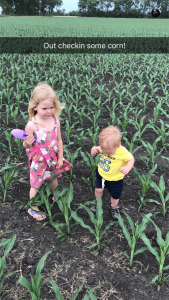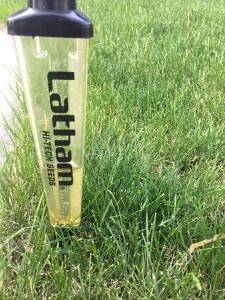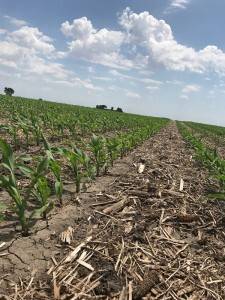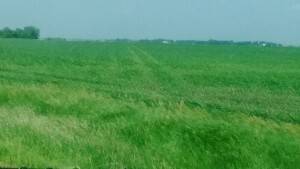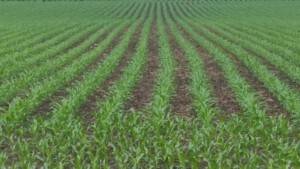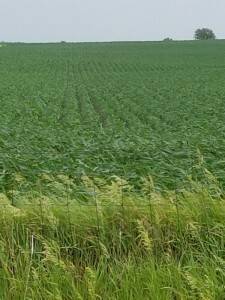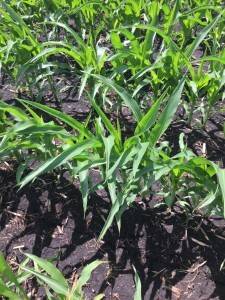From the Field Crop Report: June 14
Eastern North Dakota
Brain McNamee
The good news is that rain finally fell in some drought-stricken areas. Too bad last weekends weather event also delivered damaging hail as pictured in this field near Rugby, ND. This field was a total loss with less than 5% viable plants left.
Fortunately, the two showers that followed this storm delivered more rain and zero hail.
Emergence before the storm was very erratic, causing plant stand evaluations to be difficult. Because we haven’t had rain for so long, soybeans were planted into dry dirt and laid dormant for three weeks.
You know the hail damage is bad when cattail sloughs look like this!
Southeast North Dakota
Gary Geske
My grandkids helping scout a field of Latham LH 3877 VT2 PRO RIB.
Mid-season crop scouting is important for two reasons: (1) different weed, insect and disease pressures become evident this time of year; and (2) summer months are a crucial time to decide which traits to implement when buying seed for the next crop year. Click here for more crop scouting tips.
Northeast South Dakota
James Keltgen
It’s been an active week of weather in NESD. 3-6 inches of rain fell in the Clark and Watertown areas. Damaging winds and hail leveled fields northeast of Watertown. The good news is rain fell in the worst drought areas in central SD this week. There has been damaging storms this weekend in SD the last 3 years. Growers are baling winter wheat for feed near Gettysburg. Spring wheat may be too short to cut. Pastures are brown but corn and soybeans held on long enough to catch rains.
Southeast South Dakota
Ramie Coughlin
Look what’s cropping up in Southeast South Dakota… This week my family and I welcomed our fourth member. Daxton Ryan said hello to the world at 12:40 am on June 13, weighing in at 6 pounds, 15 ounces and stretching to 20 inches long. He is loving life on the outside, and we are loving life with him!
Northern Minnesota
Ken Highness
My grandson Casen and I are doing root digs on Latham’s experimental corn varieties in a SuperStrip plot near Felton, MN. This plot was planted May 7. At this stage, the root mass is well developed. The very white roots indicate an excellent healthy plant.
Southern Minnesota
Brandon Wendlandt
Storms came through much of southern Minnesota on Sunday and Monday and brought much needed rain. While some areas reported more, I received 2 inches of rain at my house. Some small hail was reported with the storm, but we haven’t seen crop damage from it here. Other areas did receive damaging hail and winds, so it will take a few days to assess the damage and decide a course of action.
Southern Wisconsin
Greg Mair
The cold, wet spring has caused stand reductions in all crops across the Corn Belt. A final stand evaluation is a key component to yield at harvest.
Using the Hula-Hoop method for soybeans, we determined this location in Deerfield, Wisc. had an average stand of 130,000 plants per acre (ppa). We threw a 36″ hula-hoop around the field and calculated the number of plants within by the corresponding factor (6,165) to get plants per acre. Click here for more tips on assessing corn and soybean stands.
Northwest Iowa
Darin Chapman
Check out the picket fence stand and great emergence from Latham’s LH 4955 VT2 PRO!
Northwest Iowa just received a couple shots of much needed rain in the last couple of days. Unfortunately, some received damaging hail with that rain.
South Central Minnesota & North Central Iowa
Cory Greiman
When spring weather is wet, some farmers get overly anxious about getting seed in the ground. We understand their sense of urgency, but we also know they’ll have better results if they wait for more suitable field conditions. Here’s a case in point see the wheel track compaction in a corn field due to working it when soils were too wet?
Top 10 Reasons to Avoid Soil Compaction:
- Causes nutrient deficiencies
- Reduces crop productivity
- Restricts root development
- Reduces soil aeration
- Decreases soil available water
- Reduces infiltration rate
- Increases bulk density
- Increases sediment and nutrient losses
- Increases surface runoff
- Damages soil structure
Click here for tips to avoid soil compaction.
Southeast Minnesota & Northeast Iowa
Craig Haaland
This nice looking field of LH 5010 conventional corn was planted around May 7 in Dodge Center, Minnesota. Fortunately, we’ve finally received some much needed rain. This hot, humid weather pattern is sticking. It’s going to be important to scout your fields to stay ahead of any insect and disease pressure. Scouting fields also can help you note changes needed to your 2018 crop plan.
West North Central Iowa
Bart Peterson
LH 5095VT2 PRO, planted April 11, near Rolfe in West Central Iowa has already canopied. Corn is at V6 to V7 stage.
Eastern Iowa
Jerry Broders
Time of planting and soil conditions have played a huge role in soybean emergence this planting season.
These photos were taken last week at planting time. Dry soil needs rain to help move along these plants.
Central Iowa
Bryan Rohe
High heat and no moisture is casing corn plant in Central Iowa.
Western Iowa & Eastern Nebraska
Larry Krapfl
Photo 1
LH 3158 LL planted April 18 full shade on the 15-inch rows
Photo 2
This field of LH 6317 VT2 PRO DG RIB, which was planted April 12, will be knee high before the 4th of July.
Photo 3
LH 6175 VT2 PRO RIB is nearly waist high on this Latham dealers farm in western Iowa
